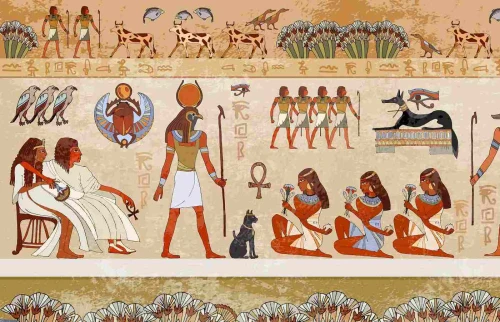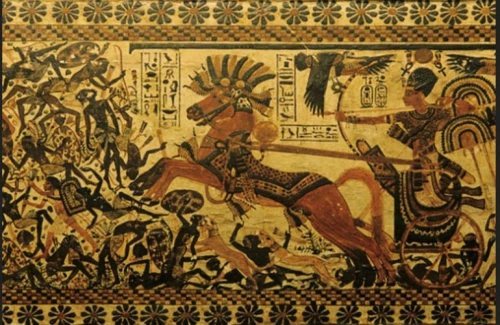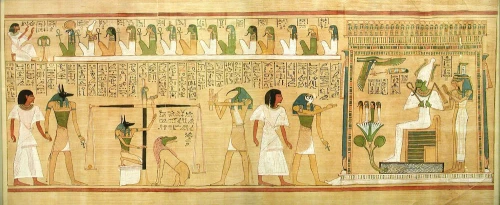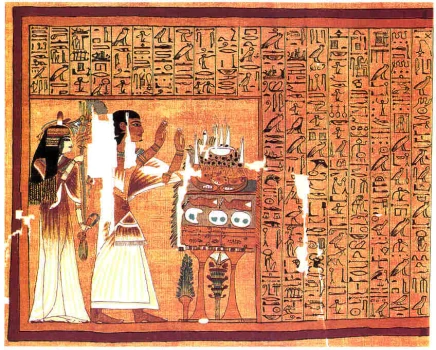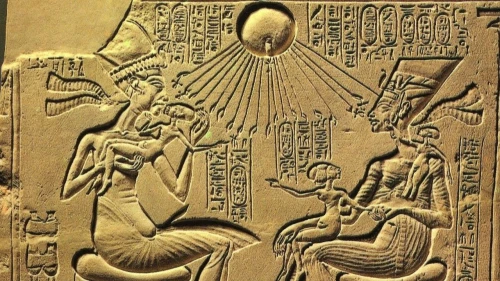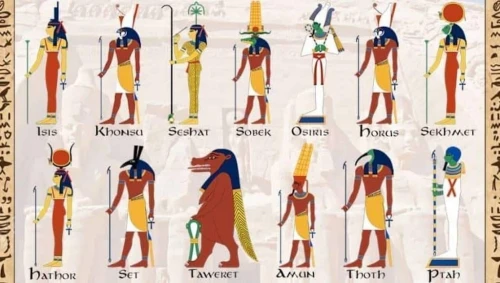
FAMILIES OF GODS (Triads)
Gods in ancient Egypt often came in threes, and families of gods were called triads. These trinities of gods, consisting usually of a father, a mother, and their child, could be found in all of the important cult centers in Egypt. Huge temple complexes grew up around the cult centers, and the priests became very powerful and wealthy.
The most important cult centers were the following:
Triad City Horus; his wife, Hathor; and Edfu their son Harsomtus (Harpa- there; Horus the child) Khnum: his wife, Anukis: Elephantine and their daughter Satis Ptah: his wife, Sekhmet: Memphis and their son Nefertum Amun: his wife, Mut: and Thebes their son Khonsu The Edfu Triad Edfu, located just south of Thebes, became an important cult center and home of the Edfu triad during the Ptolemaic dynasty (332 - 32 B.C) Horus, the falcon god, was the principal deity, and inscriptions carved on the temple walls give a complete version of the mythical story of Horus Ptah, the principal god of Memphis, which is often shown in mummiform with a close-fitting cap and holding a staff of authority. overthrowing his enemy Set. Hathor was the wife or consort of Horus, and the temple inscriptions also tell the story of her journey from her cult center in Dendera to Edfu, where the marriage of Horus and Hathor took place.
Their son Harsomtus, Horus the younger, was through magic born simultaneously at the birth houses in Edfu and Dendera. Hathor is the cow-headed goddess of love and music, and Harsomtus was at the same time a human, a falcon, and a reincarnation of the dead king; one of his titles was "Son of the Earth". The Elephantine Triad Elephantine Island is situated at Aswan. The cult center for the trinity of Khnum, Anukis, and Satis was in a town called Abdu (modern Syene). The principal god was Khnum, who wore a white crown with ram's horns and a solar disk. Occasionally he was shown with a jug on his head, a symbol for unite or build. His name may originally have had an astronomical reference, uniting the sun and the moon. Khnum is a builder or maker of men. According to his priests, he made the first egg, which produced the sun. Khnum is also believed to have fashioned men on the potter's wheel. His consort or wife, Anukis, was the goddess of cataracts, the large boulders in the river at Aswan. Their daughter, Satis, was sometimes also shown as the consort or wife of Khnum; she was the goddess of the flood or inundation.
The Memphis Triad Memphis, the capital of Egypt during the Old Kingdom (2686–2181 B.C), was known for its strong fortifications. It was called the city of walls, and shrines to Ptah were sometimes called his southern wall. Ptah was a craftsman. Following the instructions of Thoth, he created the world, and humankind, on the potter wheel. He is shown in mummiform shape wearing a skullcap. His wife or consort is the lioness-headed goddess Sekhmet, who was also the avenger of the sun god Re. In her gentler aspect, Sekhmet was a goddess of healing and medicine. Their son, Nefertum, was called the "god of the blue lotus, the blossom" with which he was associated.
The Theban Triad Amun was the principal god of Thebes, and his name means the hidden one. He can appear in many forms but was often portrayed holding a was scepter and an Ankh, the signs of power and life, and wearing a double feather crown. When Amun represented one of the primordial gods in the waters of chaos, he had the body of a man with the head of a frog. Amun's chief consort or wife was Mut, whose name means "mother", and she was sometimes "called World Mother", She Who Brings Forth into Existence. Mut was portrayed either as a woman wearing the double crown and holding a papyrus scepter or as a lioness-headed goddess.
62 FAMILIES OF GODS
Ptah, the principal god of Memphis, is often shown in mummiform with a close-fitting cap and holding a staff of authority. (Photograph by Pat Remler)
In this guise, she was associated with Sekhmet and Bastet. The third member of the triad was their son, Khonsu, the moon god. Curiously, the most popular and powerful triad that of Osiris, Isis, and their son Horus did not have a particular cult center where they were worshipped together. Instead, each one had his or her cult center: Osiris at Abydos, Isis at Philae, and Horus at Edfu.
 English
English
 Spain
Spain

